Articles, illustrations, papers, and video of asphalt and how it improves Virginia’s roadways.
NCAT Report 20-03, Benefits of Rehabilitating Concrete Pavements with Slab Fracturing and Asphalt Overlays
The benefits of using asphalt overlays for rehabilitation of Portland cement concrete (PCC) pavements are grounded in economics and long-term performance. The Federal Highway Administration (FHWA) reports that the U.S. has 108,603 lane miles of composite pavements (PCC overlaid with asphalt), which is nearly double the lane miles of PCC-surfaced pavements (FHWA 2015). That means that nearly two-thirds of the concrete pavements in the U.S. have been overlaid with asphalt. However, a persistent problem with asphalt overlays on PCC pavements is reflective cracking of joints and cracks through the asphalt overlays over time. Ultimately, reflective cracking leads to a shortened performance life of the overlay. Rather than removing the concrete, which can be costly to the owner agency and increase delay times for the traveling public, slab-fracturing techniques can be used prior to placement of an asphalt overlay to significantly reduce stress concentrations at concrete joints and cracks.
NCAT Report 19-09, Quantifying Pavement Albedo, Final Report
This project evaluated, characterized, and quantified albedo and thermal properties of real-world paving materials. Field-measured pavement albedo and thermal properties were used to develop predictive albedo and thermal models. These resulting models were then compared to AASHTOWare Pavement ME Design software and Greenroads or GreenPAVE sustainability rating systems.
NCAT Report 18-04, Phase VI (2015-2017) NCAT Test Track Findings
NCAT announced the finalized publication of NCAT Report 18-04, Phase VI (2015-2017) NCAT Test Track Findings.
Six cycles of research have now been completed at the NCAT Test Track, and the findings have helped sponsors refine their materials specifications, construction practices, and pavement design procedures for asphalt pavements.
The research topics and objectives of experiments conducted in the sixth research cycle include: cracking tests, porous friction course, bio-based rejuvenator, enhanced friction surface, softer binder for high RAP mix, stress absorbing interlayer, longitudinal joints and durability, high RAP thin overlay, friction and bond strength, 4.75 mm thin overlay, cold central plant recycling and full depth reclamation.
Evaluation of the Terminal Boulevard (SR 406) Concrete Rubblization Project
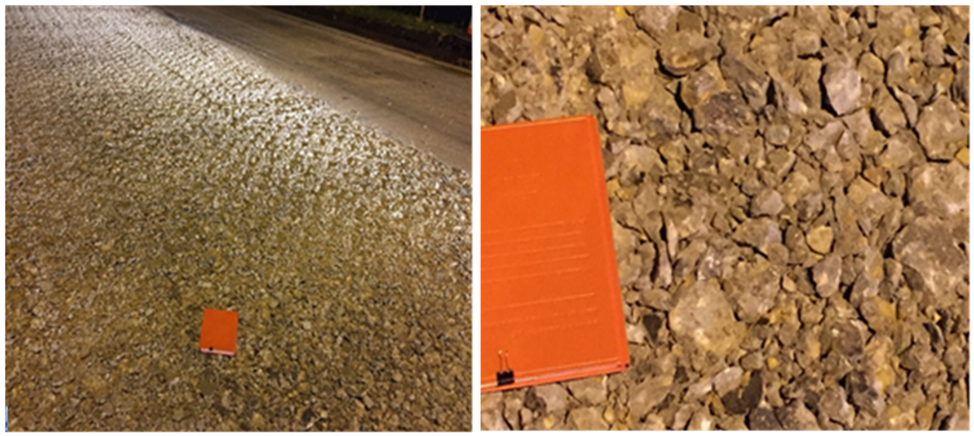
Final Rubblization Surface
In 2016, the Virginia Department of Transportation (VDOT) executed a contract to reconstruct portions of Terminal Boulevard (SR 406) in Norfolk. The work consisted of rubblizing the existing continuously reinforced concrete pavement and placing 6 in of asphalt mixture on top of the compacted rubblized concrete material. The project limits were from the
I-564 loop ramp to the intersection with Hampton Boulevard in the westbound direction and from the intersection with Hampton Boulevard to the bridge over the railroad tracks in the eastbound direction.
The purpose of this study was to document the current condition of the rubblized and reconstructed pavement on Terminal Boulevard (SR 406) and to generate baseline pavement performance information. Laboratory tests indicated that the asphalt mixtures used were expected to be rut resistant and resistant to non-load related cracking. Field tests using a falling weight deflectometer showed that the pavement section is structurally strong with a low deflection. AASHTOWare Pavement ME software showed a design life of 18 to 19 years for the pavement in terms of bottom-up fatigue cracking. The analysis also predicted higher rutting than expected. VDOT pavement management data showed an increase in roughness and rutting between 2017 and 2018, but the difference could be attributable to random variation from year-to-year testing.
The study recommends that the Virginia Transportation Research Council continue to monitor the performance of the rubblized pavement on SR 406 and report on its condition in approximately 3 and 5 years. Any lessons learned during this time should be submitted to VDOT’s Hampton Roads District and VDOT’s Materials Division for review.
HWA Asphalt Pavement Principles: Long Life Pavements
FHWA Asphalt Pavement Principles: Smoothness
FHWA Asphalt Pavement Principles: Density & Durability
Performance & Life Cycle Cost Benefits of Stone Matrix Asphalt (NCAT 18-03)
By: Dr. Fan Yin, P.E., Assistant Research Professor, National Center for Asphalt Technology; Dr. Randy C. West, P.E., Director, National Center for Asphalt Technology
Stone matrix asphalt (SMA), also called stone mastic asphalt, is a durable and rut-resistant asphalt mixture that relies on stone-on-stone contact to offer strength and a rich mortar binder to provide durability (Hughes 1999). SMA was introduced into the United States in the early 1990s mainly through the efforts of a Technical Working Group established by the Federal Highway Administration. The first SMA project in the United States was constructed in Wisconsin in 1991. Ever since, SMA has gained popularity among highway agencies as a premium asphalt mixture to
enhance field performance and extend the life expectancy of asphalt pavements and overlays. However, SMA is generally more expensive than the conventional Superpave dense-graded mixture, mainly due to higher asphalt contents, requirements for more durable aggregates, and the inclusion of fibers as stabilizers. This study was undertaken to objectively and comprehensively quantify and compare the performance and life-cycle cost benefits of SMA versus those of polymer-modified Superpave dense-graded mixtures used on similar trafficked highways. To accomplish the objective, market analysis was first conducted to determine the current usage of SMA through surveys of state highway agencies (SHAs), state asphalt pavement associations (SAPAs), and knowledgeable individuals in the asphalt pavement industry. Performance analysis was then conducted to compare the long-term field performance of pavement sections with SMA and polymer-modified Superpave dense-graded mixtures. Information gathered from the market analysis and performance analysis was then used as inputs to compare the life-cycle cost between these two
mixtures. Finally, a comprehensive review of the literature was conducted to summarize the engineering properties and field performance of SMA. Results obtained from this study provide highway agencies with additional guidance regarding the use of SMA as a premium asphalt mixture.
Structural Design Guidelines For Porous Asphalt Pavements
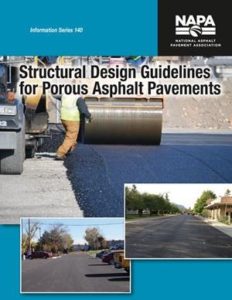 Commonly used for parking lots and other light-duty applications, full-depth porous asphalt pavements are increasingly being used on roadways as part of efforts to mitigate flooding hazards, reduce hardscape, and improve sustainability. To help ensure these new porous asphalt roadways provide reliable performance under traffic, NAPA has published Structural Design Guidelines for Porous Asphalt Pavements.
Commonly used for parking lots and other light-duty applications, full-depth porous asphalt pavements are increasingly being used on roadways as part of efforts to mitigate flooding hazards, reduce hardscape, and improve sustainability. To help ensure these new porous asphalt roadways provide reliable performance under traffic, NAPA has published Structural Design Guidelines for Porous Asphalt Pavements.Investigation of Binder Aging and Mixture Performance in Service: Reclaimed Asphalt Pavement Mixture
By: Stacey D. Diefenderfer, Ph.D., P.E., Harikrishnan Nair, Ph.D., P.E., and Benjamin F. Bowers, Ph.D., P.E. | Copyright © 2018, Virginia Transportation Research Council. All rights reserved. All product and company names are trademarks of their respective owners.
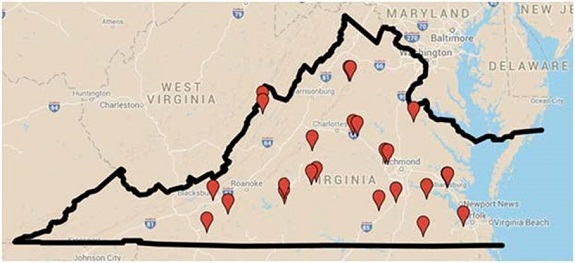 Abstract:
Abstract:
In 2007, the Virginia Department of Transportation piloted a specification allowing up to 30% reclaimed asphalt pavement (RAP) in certain dense-graded asphalt surface mixtures while changing virgin binder grade requirements. The change affected only mixtures requiring an end binder grade of either PG 64-22 or PG 70-22. For mixtures specifying PG 64-22 binder, the virgin binder grade at RAP contents of 30% or less was no longer required to change. For mixtures specifying PG 70-22 binder, the virgin binder grade at RAP contents of 21% to 30% was no longer required to change from PG 64-22 to PG 64-28. Prior to this, both types of surface mixtures were allowed to contain only up to 20% RAP before binder grade adjustments were required. An initial laboratory study of mixtures produced under the pilot specification indicated that there were no significant differences for fatigue, rutting, and susceptibility to moisture between the higher content (21% to 30%) RAP mixtures and comparison mixtures (20% RAP or less).
The current study evaluated the in-service performance of these mixtures after approximately 7 years and encompassed field visits and a laboratory investigation of a sample of 23 in-service pavements used in the initial laboratory evaluation. Cores were collected from each site and used to evaluate the binder and mixture properties. These data were compared to data from the original construction, when available, to assess the changes in the mixtures over time. Historical performance and maintenance data were also collected and evaluated to investigate the long-term performance characteristics of the sites.
Laboratory testing, including dynamic modulus determination, repeated load permanent deformation analysis, and extracted in field performance could be determined because of the underlying structural conditions. Individual locations were found to show better or worse pavement performance, but this was attributed primarily to structural differences in the pavements and preexisting conditions. Surface deterioration observed in numerous test sections included fatigue cracking, longitudinal cracking, transverse cracking, raveling, and potholes. Binder analysis indicated that depth within a layer (in this case, top half versus bottom half) significantly affects binder properties, with stiffness decreasing with depth. However, increasing RAP contents appeared to mitigate the differences between the top half and bottom half of layers, possibly because of the preexisting aged composition of the RAP and its influence on the virgin binder properties.
Read Full ReportEvaluation of Revised Incentive Only Ride Specification for Asphalt Pavements
By: Harikrishnan Nair, Ph.D., P.E., Kevin McGhee, P.E., Affan Habib, P.E., Michael Wells, P.E., Bipad Saha, P.E. | Copyright © 2018, Virginia Transportation Research Council. All rights reserved. All product and company names are trademarks of their respective owners.
Abstract:
In late 2011, the executive leadership of the Virginia Department of Transportation (VDOT) formed an Asphalt Quality Task Force to identify and recommend specific achievable measures to improve the quality of asphalt paving in Virginia. The task force recommended that VDOT assess the feasibility of making an incentive-only provision for ride quality the default for projects that do not qualify for VDOT’s regular specification for rideability, which includes both incentives and disincentives. A pilot application of the incentive-only provision was conducted during VDOT’s 2013 construction season. Although the results indicated no statistically reliable distinction in ride quality between the projects under the incentive-only provision and those with no rideability requirement, the number of sites, VDOT districts, contractors, etc., included in the assessment was limited.
The research summarized through this study addressed a concern that the criteria for the ride specification in the original (2013) incentive-only provision may have failed to reflect quality adequately beyond a limited 52.8 ft (0.01-mi) base length. The study documented the application of an incentive-only provision to a wider range of projects during VDOT’s 2015 construction season. The revised criteria addressed some of the concerns associated with the original criteria. The revised provision maintains the potential for incentives while reducing the likelihood for “accidental” bonuses when the final ride quality is marginal on average but highly variable. Overall, there remains little statistically reliable distinction between the achieved ride quality of projects under the incentive-only provision and of general resurfacing projects with no ride quality requirement. However, based on before and after determinations of the International Roughness Index, greater improvements in ride quality were achieved with the incentive-only pilots (at least in some cases) as compared to sites under no ride quality requirement. The revised incentive-only provision provides a mechanism through which a contractor has an opportunity to recover costs associated with improved practices and perhaps even earn incentives based on good ride quality. It does this while reducing the risk that VDOT will be subject to incentives for otherwise marginal quality work.
The study recommends that VDOT continue to promote and administer an incentive-only provision for qualifying resurfacing activities in accordance with the criteria recommended in this study. However, VDOT should continue to monitor the data from projects under the incentive-only provision and assess the effectiveness and benefit of the revised provision, provided in the Appendix, once it is applied on a larger basis.
Evaluation of Porous Asphalt Used at VDOT Park & Ride Facility
By: Michael Fitch, Ph.D., and Benjamin F. Bowers, Ph.D., P.E. | Copyright © 2018, Virginia Transportation Research Council. All rights reserved. All product and company names are trademarks of their respective owners.
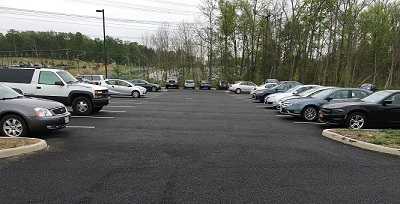
Completed Porous Asphalt Park & Ride Facility
Abstract:
Recognizing the increasing emphasis on reducing stormwater runoff associated with transportation facilities and the changes in the Virginia Department of Environmental Quality’s Stormwater Management Program Permit Regulations, the Virginia Department of Transportation (VDOT) has taken the first step in examining ways in which permeable pavements can be used in place of conventional impervious pavement materials.
Like many departments of transportation, VDOT has minimal experience using permeable pavements of any type. As a consequence, many questions remain to be answered before VDOT can confidently use these types of pavements as stormwater best management practices in place of more commonly used stormwater control measures. The objective of this study was to develop a better understanding of how porous asphalt would perform when it is maintained using four different protocols: (1) no maintenance, (2) regenerative air vacuuming at 6-month intervals, (3) conventional vacuuming at 6-month intervals, and (4) regenerative air vacuuming at 12-month intervals. To meet these objectives, a Park & Ride facility operated by VDOT was paved with porous asphalt, maintained, and monitored for 4 years.
Although infiltration rates slowed substantially over the monitoring period, the lot continued to function as a stormwater best management practice (BMP) with an average infiltration rate approximately 12 times the required minimum of 10 in/hr. The different maintenance protocols tested did not have an effect on the rate of infiltration decline, indicating the reduction in permeability is likely not the result of sedimentation. It is estimated that the lot, constructed in 2013, will continue to function as an effective stormwater BMP until at least 2025 and will cost less than $1,500 per year to maintain.
Based on these findings, the study recommends that VDOT’s Location and Design Division continue to consider porous asphalt as a stormwater BMP option for Park & Ride facilities when deciding on the most cost-effective BMP based on site-specific conditions. Further, the study recommends that VDOT’s Materials Division oversee the formation of an advisory group to help determine in what settings porous asphalt can be used best by VDOT. This will help ensure that a comprehensive approach is taken when determining if porous asphalt could be used as a stormwater BMP in locations other than Park & Ride facilities.
Read Full ReportA Comparison of the I-64 Rehabilitation
Reprinted from Virginia Asphalt Magazine Fall 2017
By: Trenton M. Clark, P.E.
Over the life of a structure, maintenance and rehabilitation are required to maintain a minimum level of performance. Pavements are no different . Asphalt surfaces must be renewed to restore ride quality and reduce noise levels. Concrete surfaces require patching of the joints/cracks and grinding or overlay to restore the same functional attributes. In the early 2000’s, the exposed concrete pavement on I-64 in the Richmond District and Hampton Roads Districts was badly deteriorated and in need of restorative maintenance (see picture of York County JRCP). The concrete pavement joints had spalled and faulted; many of the joints had been replaced over the years and the concrete surface in the middle of the slabs had cracked and spalled.
. Asphalt surfaces must be renewed to restore ride quality and reduce noise levels. Concrete surfaces require patching of the joints/cracks and grinding or overlay to restore the same functional attributes. In the early 2000’s, the exposed concrete pavement on I-64 in the Richmond District and Hampton Roads Districts was badly deteriorated and in need of restorative maintenance (see picture of York County JRCP). The concrete pavement joints had spalled and faulted; many of the joints had been replaced over the years and the concrete surface in the middle of the slabs had cracked and spalled.
Shattering Concrete To Restore Terminal Blvd
Reprinted from Virginia Asphalt Magazine Fall 2016
By: Virginia Paving Company
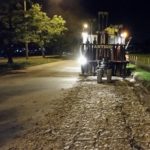 Terminal Blvd. serves as the main roadway for inbound and outbound container trucks traveling to Norfolk International Terminals – one of the busiest ports on the east coast – as well as a route to Naval Station Norfolk. Over time, high truck traffic has led to the deterioration of the 9-inch thick continuously reinforced concrete pavement. Asphalt and concrete patches, as well as asphalt overlays, had been used in the past to repair areas of failing pavement and correct settlement, but overall, the roadway was still in poor condition.
Terminal Blvd. serves as the main roadway for inbound and outbound container trucks traveling to Norfolk International Terminals – one of the busiest ports on the east coast – as well as a route to Naval Station Norfolk. Over time, high truck traffic has led to the deterioration of the 9-inch thick continuously reinforced concrete pavement. Asphalt and concrete patches, as well as asphalt overlays, had been used in the past to repair areas of failing pavement and correct settlement, but overall, the roadway was still in poor condition.
US 40 And MD 213 Maryland
Asphalt Outperforms Concrete at Maryland Intersection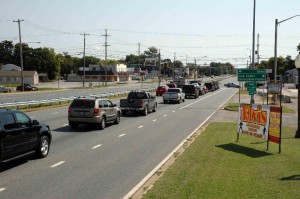 Reprinted from the Ohio Asphalt Magazine Fall 2013
Reprinted from the Ohio Asphalt Magazine Fall 2013
The intersection of U.S. 40 and MD 213 topped the list of “trouble spots” for the Maryland State Highway Administration (SHA) network as early as 1993. The high daily traffic count and the large percentage of truck traffic resulted in excessive pavement deformation which needed to be addressed once or twice a year at a great expense. The Asphalt Industry was challenged to come up with a solution for the eastbound travel, passing and right-turn lanes of U.S. 40 at MD 213.
Read Full ArticleI-264 Norfolk
Motorists praise smooth commutes on I-264 after work
Copyright (c) 2013, The Virginian Pilot/PilotOnline.com. Posted with permission.
Written By: Dave Forester | Video By: Brian Clark
Tommy Nuttycombe started to avoid the Downtown Tunnel not because of traffic, but because of what lay beyond it.
The pavement on Interstate 264 in Norfolk was so full of craggy holes, bumps and rough edges that the retired brick salesman and Harley-Davidson rider didn’t trust it with his life.
“It got so bad, to tell you the truth, I was afraid of it,” he said.
Fear, hatred, disgust – the pavement on I-264 and nearby I-64 had for years inspired dark emotions among Hampton Roads motorists. But in recent weeks, a dreamy new coating of asphalt – the latest step in a year’s long process to rehabilitate the roads – has people turning downright affectionate.
Read Full ArticleI-66 Fairfax
ASPHALT PAVING: Driving on the roof
Copywrite (c) 2013, Road & Bridges Magazine
By: Trenton M. Clark, P.E., David P. Shiells, P.E., and David A. White
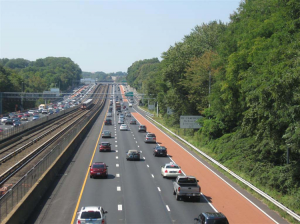 Just west of Washington, D.C., I-66 in Fairfax County, Va., is one of the busiest commuter routes in the country.
Just west of Washington, D.C., I-66 in Fairfax County, Va., is one of the busiest commuter routes in the country.
Between 162,000 and 178,000 vehicles per day travel on I-66—far greater traffic levels than were expected when the road opened to traffic in 1963. A major pavement-rehabilitation project in 2011 and 2012 turned the stretch of road from a nightmare to a dream, with a smoother, quieter ride. Stone-matrix asphalt (SMA), a premium surfacing material for high-volume roadways, played a starring role in the transformation.
Read Full Article